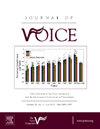Singing Voice Symptomatology Following Presumed SARS-CoV-2 Infection
IF 2.5
4区 医学
Q1 AUDIOLOGY & SPEECH-LANGUAGE PATHOLOGY
引用次数: 0
Abstract
The impact of continued COVID-19 sequelae on singers’ vocal function has yet to be determined. An online survey of singers who have contracted SARS-CoV-2 infection was designed and administered globally. Participants (n = 1,153) were recruited in Africa, the Americas, Asia, Australia, and Europe. Survey questions included demographics, peri- and post-SARS-CoV-2 infection symptoms, and self-reported sequelae attributed to long-COVID. The survey was made available in English, Portuguese, Spanish, and Traditional and Simplified Mandarin Chinese. Data were statistically analyzed to provide a useful summary of the sample and to evaluate associations between long-COVID and singers’ vocal function. We found that age, gender, and vaccination status were not significantly correlated to a change in singing voice in our sample. However, severity of infection was statistically correlated with a change in singing voice. Of the 34 signs and symptoms presented, lingering cough, shortness of breath, and chronic fatigue were significantly correlated with a change in singing voice. These data and their analyses have added to our understanding of this growing population's unique vocal needs, and may inform strategies for singing voice habilitation in COVID-19 survivors.



推测感染 SARS-CoV-2 后的歌声症状
COVID-19 后遗症对歌手发声功能的影响尚待确定。我们设计并在全球范围内对感染过 SARS-CoV-2 的歌手进行了在线调查。在非洲、美洲、亚洲、澳大利亚和欧洲招募了参与者(n = 1,153)。调查问题包括人口统计学、SARS-CoV-2 感染前后的症状,以及自我报告的长期 COVID 后遗症。调查以英语、葡萄牙语、西班牙语、繁体中文和简体中文进行。我们对数据进行了统计分析,以便对样本进行有用的总结,并评估长COVID与歌手声乐功能之间的关联。我们发现,在我们的样本中,年龄、性别和疫苗接种情况与歌唱嗓音的变化没有明显的相关性。但是,感染的严重程度与歌声的变化有统计学上的相关性。在出现的 34 种体征和症状中,持续咳嗽、呼吸急促和慢性疲劳与嗓音变化有显著相关性。这些数据及其分析加深了我们对这一日益增长的人群独特嗓音需求的了解,并可能为 COVID-19 幸存者的歌唱嗓音适应策略提供参考。
本文章由计算机程序翻译,如有差异,请以英文原文为准。
求助全文
约1分钟内获得全文
求助全文
来源期刊

Journal of Voice
医学-耳鼻喉科学
CiteScore
4.00
自引率
13.60%
发文量
395
审稿时长
59 days
期刊介绍:
The Journal of Voice is widely regarded as the world''s premiere journal for voice medicine and research. This peer-reviewed publication is listed in Index Medicus and is indexed by the Institute for Scientific Information. The journal contains articles written by experts throughout the world on all topics in voice sciences, voice medicine and surgery, and speech-language pathologists'' management of voice-related problems. The journal includes clinical articles, clinical research, and laboratory research. Members of the Foundation receive the journal as a benefit of membership.
 求助内容:
求助内容: 应助结果提醒方式:
应助结果提醒方式:


